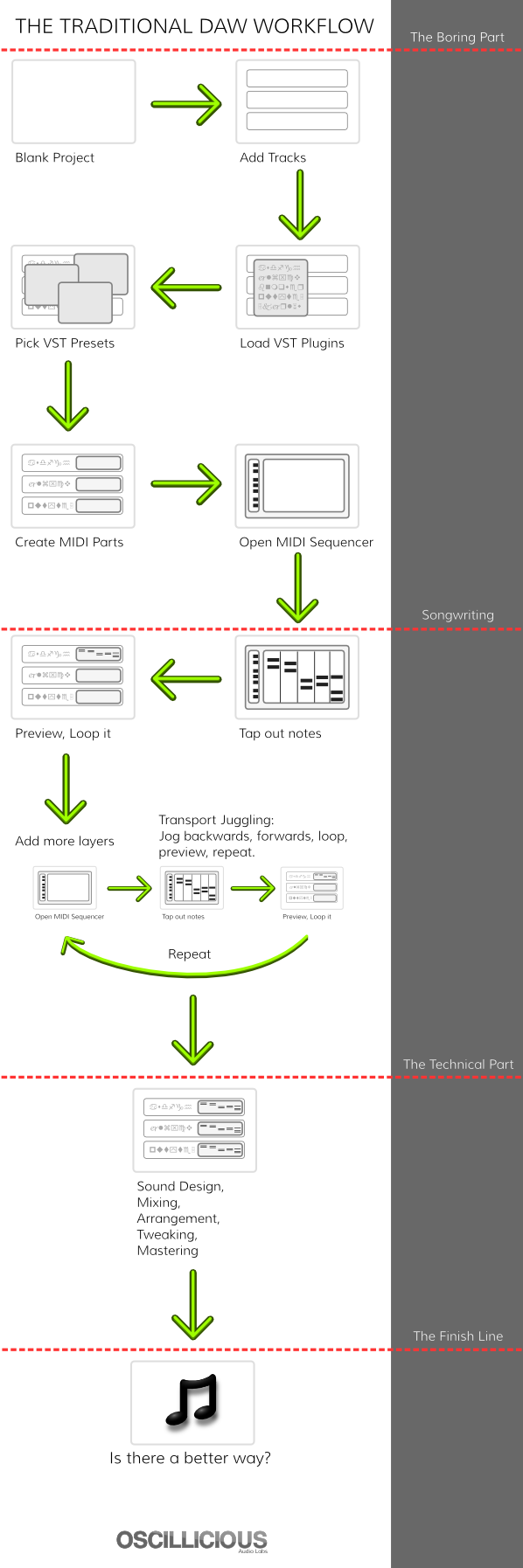I’ve been thinking a lot about music production workflows lately. Digital Audio Workstations (DAWs) can be incredible tools. They combine MIDI sequencers, audio editors, pattern editing, and allow you to drop plugins like SodaSynth into them as extra instruments or effects. With all of these features, most DAWs provide an all-in-one solution for music making, and are used by everyone from complete beginners to the best producers in the world.
But all of these features come at a price, both in dollars and time. High-end DAWs can be priced toward professionals and studios. The competition between DAWs has lead to feature creep, which has directly resulted in very complicated user interfaces, and incredibly steep learning curves. Adam and I like to joke that DAWs should brag about how many knobs per square cm they pack into their user interface. It’s almost ridiculous.
DAWs are powerful, but as many musicians will attest, they’re also difficult to learn. However, once you get a hang of how to use a DAW, get used to the workflow, and master the technical aspects of producing, you’re set.
Or are you?
In my next blog post, I’ll take a crack at answering that question. I’ve mocked up a diagram (below) exploring one of the main workflows for writing music in a DAW.
In the meantime, leave a comment and let me know what you think of the diagram! Does this fit your workflow?



This seems to be the typical workflow for loop-based electronic music made with DAWs, and I think the proclivity of this kind of repetitive, loop-based music has a lot to do with the typical DAW interface that’s used to make this kind of music. If you think about it, when you’re composing a piece of music you should usually be trying to convey a specific thought or emotion. The usual composition method with DAWs tends to be the other way around; the emotion of the piece of music is determined by how the program’s “user” (composer?) has gone through these steps.
I’d recommend fleshing out the composition before you even get to the DAW stage. Compose the piece on an instrument, write it out on paper or even using a composition software like Sibelius, then “produce” it using the DAW.
I’m not necessarily against loop-based electronic music (I love acid techno, psytrance, drum and bass, etc.), but it’s 2012 and it’s time to start coming up with something new. It’s also good to experiment with new ways of doing things and expand your horizons in method.
Yeah, good points. I think the state of music hardware and software has had a very noticeable influence on electronic music, at least from the 90s through to the mid-2000s.
I definitely agree that the way we’ve encouraged to use DAWs (by the way their interfaces are designed) is a bit backwards, as you said. I hope there’s a big future in this approach of separating the composition and production. One could imagine that reforming the way that music production software works could really influence the type (and quality) of music that people produce, just like new software helped create new genres of electronic music.
Thanks for reading!
Pingback: The Trouble with DAWs: Recording | The Oscillicious Blog